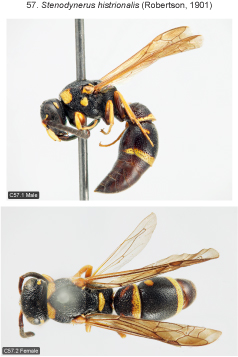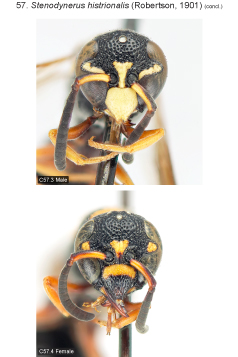
| Home | Table of contents | Keys | Species list | Glossary | Image data | PDF | Cite this article | Feedback | Updates |
Identification Atlas of the Vespidae (Hymenoptera, Aculeata) of the northeastern Nearctic region
CJAI 05, February 19, 2008
doi: 10.3752/cjai.2008.05
Matthias Buck, Stephen A. Marshall, and David K.B. Cheung
Department of Environmental Biology, University of Guelph, Guelph, Ontario, Canada N1G 2W1
Next species | Previous species | Key
57. Stenodynerus histrionalis (Robertson, 1901)
Figs B7.15, 34, 66; C57.1–4.

|

|
Species recognition. A combination of characters is required to diagnose this species: clypeal apex emarginate (not truncate as in S. anormis-group), no eyelid-like swelling behind mid ocellus (present in S. blepharus and related species), pronotal carina entire but sometimes low medially (interrupted medially in several species), humeral carina absent (present in S. fundatiformis). Stenodynerus histrionalis is one of four species in the genus in which the row of pits in the transverse basal groove of tergum 2 (below overhang of tergum 1) is obsolete medially (i.e., there are only ca. 2 pits on each side). A similar condition is found in S. krombeini (pits even more reduced), S. lineatifrons (pits slightly better developed than in S. histrionalis) and S. pulvinatus (only median pits obsolete).
Variation. Fore wing length 5.5–6.0 mm (♂♂), 6.0–7.5 mm (♀♀). Variation otherwise not studied.
Distribution. Not recorded from Canada. Eastern U.S.: NY to FL, west to CO and TX (Krombein 1967). The reddish Floridian form has been described as ssp. rufustus Bohart, 1974; ssp. paenevagus (Viereck, 1906) occurs in KS, CO and TX.
Biology. Nests in borings in wood. Nest partitions and closing plugs are made of firmly agglutinated sand. Prey consists of caterpillars of Tortricidae and Gelechiidae (Krombein 1967, 1979).
Next species | Previous species | Key
| Home | Table of contents | Keys | Species list | Glossary | Image data | PDF | Cite this article | Feedback | Updates |
